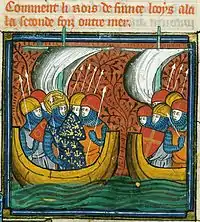Varennes, Somme
Varennes (French pronunciation: [vaʁɛn] ⓘ; also: Varennes-en-Croix)[3] is a commune in the Somme department in Hauts-de-France in northern France.[4]
Varennes | |
|---|---|
 The church in Varennes | |
.svg.png.webp) Coat of arms | |
Location of Varennes | |
 Varennes  Varennes | |
| Coordinates: 50°03′01″N 2°32′06″E | |
| Country | France |
| Region | Hauts-de-France |
| Department | Somme |
| Arrondissement | Péronne |
| Canton | Albert |
| Intercommunality | Pays du Coquelicot |
| Government | |
| • Mayor (2020–2026) | Sylvie Brood[1] |
| Area 1 | 7.24 km2 (2.80 sq mi) |
| Population | 218 |
| • Density | 30/km2 (78/sq mi) |
| Time zone | UTC+01:00 (CET) |
| • Summer (DST) | UTC+02:00 (CEST) |
| INSEE/Postal code | 80776 /80560 |
| Elevation | 83–156 m (272–512 ft) (avg. 147 m or 482 ft) |
| 1 French Land Register data, which excludes lakes, ponds, glaciers > 1 km2 (0.386 sq mi or 247 acres) and river estuaries. | |
Geography
Varennes is situated 15 miles (24 km) northeast of Amiens, at the junction of the D47, D447 and D179, in the form of a cross.
History
Middle Ages

The settlement of Franc-Mailly was located at the site of the present-day cemetery of Varennes, where the seigneurs made their home, with a farm and a mill. Wishing to promote the culture of their region, land was granted to the people to build homes, free from any kind of duties and taxes. Over time the village of Franc-Mailly became a popular haunt for criminals. According to tradition, in 1069 the four corners of the village of Franc-Mailly were burnt down on the orders of the Seigneur. The remaining core of the village, grouped around the manor house, became Varennes.[5]
Florent de Varennes, lord of Varennes, son-in-law of John II, Count of Soissons, became the first Admiral of France, heading the naval journey to North Africa, where Saint Louis IX led the Eighth Crusade. Like the King and Prince John Tristan of France, Count of Valois, he died in front of Tunis in August 1270, due to dysentery. His coat of arms "Gules a Cross Or" (Red with a gold cross) is still the coat of arms of the village.
Charles the Bold
In 1472, Charles the Bold invaded Picardy in retaliation against Louis XI who had refused to ratify the treaty on October 3, 1471 in which Charles claimed possession of Amiens, Saint-Quentin and the Vimeu. Many villages were burnt down, including that of Varennes, which was rebuilt with its streets in the shape of a cross".[6]
The Thirty Years' War and the tunnels of Varennes
During the Thirty Years War, Varennes suffered looting and destruction by Spanish troops, as testified by a verbatim record of 1636, in which it says that the village was burned down in September 1635.[7]
In order to protect themselves from armed troops, the inhabitants of Varennes dug a large tunnel. The underpass beneath the town square and the church is made up of a gallery 39m long with 29 rooms, all of which were fitted with wooden doors. Eight of the rooms had wells for fresh water.
In the most recent excavations in 1970, various inscriptions were noted on the walls: "1636 Adrien Lefebvre"; “1660 Guillomin Ringard”; “Antonin Goubet in the year 1677"; they also found a coin dated 1656.
Having served as an underground refuge for the population, the tunnels were probably used as a workplace in the winter. They were eventually closed because of the danger of collapse.[8]
War of 1870
In September 1870, during the Franco-Prussian War, Varennes was occupied by the Germans for three or four days, the village was subjected to theft, damage to housing and they had to feed the enemy troops and horses. The village was also forced to pay war reparations to the tune of 4122 Francs.
First World War
In 1916, the front line between the French and German forces was located about 7 kilometres (4 mi)from Varennes. Many underpasses were constructed and occupied in the surrounding villages, the tunnels of Varennes was occupied until Easter 1918 by British troops. In the tunnels, there’s an inscription “J. Connoly, Smith, Baker Sgt, 1918”.[8]
Places of interest
- The church, rebuilt in 1771 with materials taken from the château of Hyerville, which had been destroyed after the death of Catherine de Rinchevalle. The church has a single nave. In 1803 the tower of 1771 was rebuilt.
Heraldry
| "Gules a Cross Or", coat of arms of the village of Varennes was the one of Florent de Varennes, the very first Admiral of France[9] |
Population
|
| ||||||||||||||||||||||||||||||||||||||||||||||||||||||||||||||||||||||||||||||||||||||||||||||||||||||||||||||||||
| Source: EHESS[10] and INSEE (1968-2017)[11] | |||||||||||||||||||||||||||||||||||||||||||||||||||||||||||||||||||||||||||||||||||||||||||||||||||||||||||||||||||
See also
References
- "Répertoire national des élus: les maires". data.gouv.fr, Plateforme ouverte des données publiques françaises (in French). 2 December 2020.
- "Populations légales 2020". The National Institute of Statistics and Economic Studies. 29 December 2022.
- Varennes-en-Croix, Communauté de communes du Pays du Coquelicot
- Commune de Varennes (80776), INSEE
- A. de CARDEVAQUE relate les débuts de Franc-Mailly et de Varennes dans Varennes et l’abbaye de Clairfay, in La Picardie, 1879, Archives Départementales de la Somme, 16REV22. Cependant il est le seul à mentionner ces événements.
- A. de CARDEVAQUE, Varennes et l’abbaye de Clairfay, in La Picardie, 1879, Archives Départementales de la Somme, 16REV22.
- A. BOUTHORS, Les cryptes de Picardie, 1838, pièces justificatives p. 166-167, Archives Départementales de la Somme, 3REV1.
- J-P. FOURDRIN, Les souterrains de Varennes, 1972, in Revue de la société des Antiquaires, Archives Départementales de la Somme, 2REV54.
- Père Anselme de Sainte-Marie (1625-1694), "Histoire généalogique et chronologique de la maison royale de France, des pairs, grands officiers de la couronne & de la maison du Roy, & des anciens barons du royaume ...", Third Edition, Ed. Compagnies des libraires associés, Paris, 1733, Seventh Tome, Amirals de France, p 732
- Des villages de Cassini aux communes d'aujourd'hui: Commune data sheet Varennes, EHESS (in French).
- Population en historique depuis 1968, INSEE